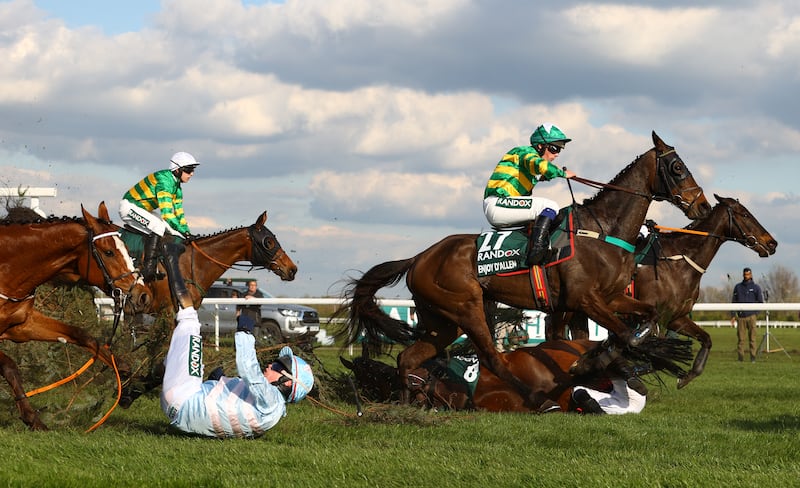For each of the last two years, ITV’s terrestrial coverage of the Randox Aintree Grand National has recorded viewing figures in Britain of 7.5 million. That’s a million more than watched England’s dramatic late victory over Ireland in last month’s Six Nations rugby match. So, it’s safe to assume the public’s social contract with the world’s most famous horse race is signed, sealed and delivered.
On top of that 7.5 million are those who watch the Grand National differently, either on specialist racing channels, streaming, or even perhaps on an annual risqué expedition to a bookies shop for a once-a-year flutter. Overall, an estimated global audience of 500 million tunes in for one of the most immediately identifiable events in sports.
They are numbers that underline how the National simultaneously provides the sport with its greatest and most fraught shop window. With the spotlight comes scrutiny on jump racing’s most uncomfortable reality; that with thrills come spills and the statistical inevitability that some of them at some point will result in fatal injuries.
British Horseracing Authority statistics show a percentage of fatalities to runners in cross-channel jump racing of just over 0.4 per cent. The rate in the Grand National has been more than double that. There have been 16 deaths in the National since 2000 including the unfortunate Hill Sixteen who broke his neck at the first fence a year ago.
READ MORE
That was after a 15-minute delay to the start of the race due to animal rights demonstrators who tried to glue themselves to a fence. Hill Sixteen’s trainer was convinced the frantic atmosphere that arose on the back of that contributed to the horse, normally a reliable jumper, not concentrating properly and paying the ultimate price.
[ Langer Dan facing top-level test at AintreeOpens in new window ]
Inevitably, the Animal Rising group dismissed that and enthusiastically made the most of the sort of platform any fringe organisation dreams of. From the point of view of piggybacking one of the sport’s most high-profile events to further an agenda – one that in this case wants not just racing banned but animals to be rewilded and an end to keeping domestic pets – it was a huge “spectacular”.
Animal Rising has said it won’t be demonstrating tomorrow. But it is the zealot’s privilege to change their mind since their actions are always right. Even if one group does what it says it will do, the pay-off in exposure from last year’s disruption could encourage another. And there is always the chance of freelance opportunism. It means the authorities will still be on high alert come 4pm.
Once the race begins, however, is when it becomes obvious how charged with risk the National shop window is.

It is impossible to make racing safe. Even in flat racing there is risk. The thoroughbred as a species can be both remarkably resilient and frighteningly fragile. Potential injury is always just a step away, never mind at the other side of each of the National’s 30 fences. But if it can’t be made completely safe, it must be as safe as possible, and be seen as such.
The National challenge is a different creature to the one that legends such as Red Rum and Aldaniti faced in their heyday. The old line about “Rummy” was he loved the large fences because he got a rest in the hang-time over them. But while the spruce fences look the same, after decades of alterations they are vastly easier to jump.
In 2013 the timber cores were removed from the fences and replaced with plastic. If the trick had been for horses to get back on their hocks and gain altitude, it is now almost an exercise in hurdling, brushing through the tops and not wasting time in the air. Tiger Roll specialised in it and became a modern-day National legend. Over the old fences he’d hardly have got past the first.
There are fresh new changes to try to improve safety this year. Placing the first fence 60 metres closer to the start might slow the runners down early. Putting the start time forward to 4pm looks little more than cosmetic. A standing start may cut out the false varieties. But the most significant change is cutting the field from 40 runners to 34.
It will encourage traditionalists to further argue that the National has been changed beyond all recognition and that the lottery element that captured the public imagination for nearly two centuries has mostly gone. The first National winner of all in 1839 was called Lottery and the assumption that even the biggest outsider might upset the odds has been crucial to the race’s appeal.
That requires the uncomfortable acknowledgment that risk is part of the attraction. Might a National with no fallers even lessen its allure? Not up for discussion is how extremists eager to see the end of the race are vastly outnumbered by a public who continue to sign up for a spectacle that now looks just about as safe as an inherently risky but thrilling event can be.
Something for the Weekend
As for what wins, that’s easy: Mahler Mission (4.00) finished runner up in the Coral Gold Cup despite losing shoes during the race, is still on a career upswing, stays all day, loves the mud and might even be still ahead of the handicapper. A slight worry is John McConnell’s recent stable form but both he and jockey Ben Harvey can be first-time lucky in the National.
After Rachael Blackmore mistakenly presumed a false start, pretty much everything else went wrong too for Quilixios (5.00) in the Arkle at Cheltenham. Presuming he has fully recovered, Henry de Bromhead’s runner is worth another shot in the Maghull.

















